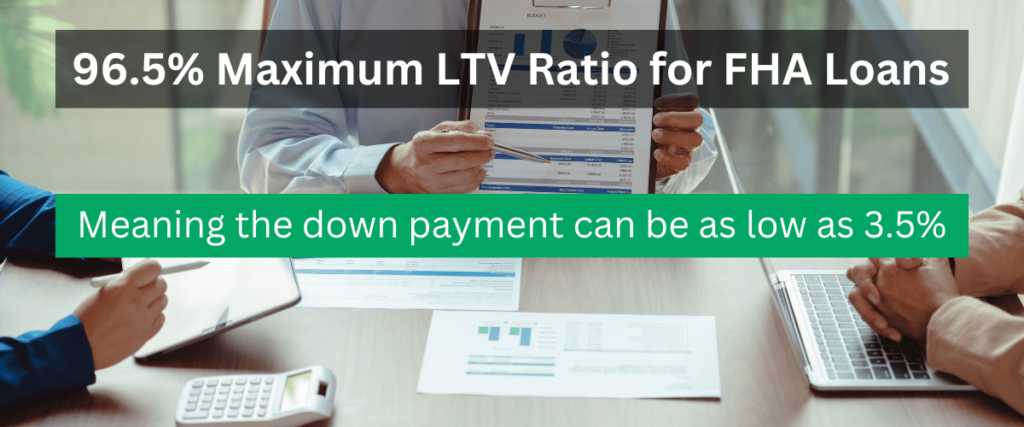
By Brandon Cornett | © 2024 FHAhadbook.com. All rights reserved.
If you plan to use an FHA loan to buy a house, you’ll be limited to a certain loan-to-value ratio, or LTV.

The maximum loan-to-value ratio for the FHA mortgage insurance program is 96.5%, according to official HUD guidelines. This means that eligible borrowers can make a down payment as low as 3.5% of the home’s value or purchase price (usually the lesser).
Not familiar with this terminology? Don’t worry. We’re about to take a deep dive into the LTV ratio requirements for FHA-insured mortgage loans, and how they relate to you as a borrower.
Learning about mortgage loan programs often feels like learning a new language. The lending industry has its own unique jargon, including a vast array of acronyms and abbreviations.
Here are two terms you need to know for the rest of this guide to make sense:
To calculate the loan-to-value ratio, you simply divide the loan amount by the appraised home value. For example, if I borrow $335,000 to purchase a house that’s valued at $350,000, the resulting LTV ratio would come to 95.7%. The math: (335,000 ÷ by 350,000 = 0.957, or 95.7%)
The FHA loan program allows eligible borrowers to make a down payment as low as 96.5%. This translates to an LTV ratio as high as 96.5%. Conventional mortgage loans, on the other hand, often require borrowers to make larger down payments resulting in lower LTV ratios.
That’s one of the reasons why home buyers (and especially first-time buyers) use FHA loans in the first place. This program allows them to finance a pretty big chunk of the purchase price, with a maximum loan-to-value ratio of up to 96.5%.

But there’s a catch. To qualify for the maximum LTV ratio, a borrower will need to have a credit score of 580 or higher. If your score falls below 580, you would be required to make a down payment of 10% resulting in a much lower LTV ratio of 90%.
In other words, home buyers with credit scores below 580 cannot borrow as much with an FHA loan, and therefore have to pay more money out of pocket.
The maximum loan-to-value requirement can be found in HUD Handbook 4000.1 (also known as the Single Family Housing Policy Handbook). In Part II of the handbook, within a section entitled “Allowable Mortgage Parameters,” we find the following:
“For purchase transactions, the maximum LTV is 96.5 percent of the Adjusted Value.”
Note: This requirement is for home purchase loans, in particular. HUD has different guidelines for special programs and products, including refinances. The maximum LTV for those programs are based on requirements listed in the “Programs and Products” section of the 4000.1 handbook.
The table below shows the minimum credit score for FHA eligibility and maximum financing. This table was adapted from HUD’s Single Family Housing Policy Handbook.
| If your score is… | Then you are… |
| 580 or higher | eligible for maximum financing (96.5% LTV) |
| between 500 and 579 | limited to a maximum LTV of 90% |
| 499 or lower | not eligible for an FHA-insured mortgage loan |
This table reiterates all of the key points we covered above:
The FHA loan program allows for a relatively high LTV ratio. This means that borrowers can make a fairly low down payment, as little as 3.5% of the purchase price. That’s one of the main benefits of this program.
The next logical question is, how does this compare to conventional or “regular” mortgages? Does the FHA program allow for a higher loan-to-value ratio when compared to conventional financing?
In many cases, the answer is yes. FHA loans often permit borrowers to have a higher LTV, when compared to a conventional (or non-government-backed) mortgage loan.
Let’s clear up some more terminology before continuing:
These days, most conventional loans have a maximum loan-to-value ratio of 95%. This in turn means that the borrower must make a down payment of at least 5% to qualify.
The FHA loan program, on the other hand, generally allows for a higher LTV ratio and therefore a lowerminimum down payment. That’s one of the main reasons why borrowers with limited funds gravitate toward this program.
To be clear: Some conventional mortgages allow for a loan-to-value ratio up to 97%, with a 3% down payment. Fannie Mae’s HomeReady program is a good example. But these programs are often limited to first-time buyers and/or borrowers with low incomes.
The more mainstream conventional loans usually require at least 5% down, compared to the 3.5% minimum down payment for an FHA loan.
It’s worth mentioning that the VA loan program for military members and veterans allows for an LTV ratio up to 100%. This means the borrower can finance the entire home purchase price, without the need for a down payment.
This is an important point, because a lot of people who are qualified for FHA financing are also qualified for the VA home loan program. And the VA program is hard to beat. VA loans don’t require a down payment or mortgage insurance, and have very flexible criteria.
But they’re not for everyone. Only military members, veterans, and surviving spouses can qualify for a VA-backed mortgage.
Disclaimer: Every lending scenario is different because every borrower is different. As a result, portions of this article might not apply to your particular actuation. The best way to determine if you are qualified for an FHA loan is to get pre-approved through a HUD-approved mortgage lender.